| |
08:00
|
1148.
 |
An Efficient 3D RF Simulation Tool for Dielectric Shimming
Optimization 
Jeroen van Gemert1, Wyger Brink2,
Andrew Webb2, and Rob Remis1
1Circuits & Systems, University of Technology,
Delft, Netherlands, 2Radiology,
Leiden University Medical Center, Leiden, Netherlands
High permittivity materials, in the form of “dielectric
pads” are used in neuroimaging and body applications to
improve B1+ homogeneity
and intensity or to reduce corresponding SAR measures. In
3D, systematic pad design is computationally intensive with
very long associated simulation times. We propose a hybrid
solution to this problem by combining the flexibility of
FDTD to model complex background configurations
(coil/shield/subject) with an integral equation approach
that takes the presence of a dielectric pad into account.
This solution leads to speed up factors of 30 – 40 compared
with conventional FDTD approaches and enables effective 3D
dielectric pad design.
|
| |
08:12
|
1149.
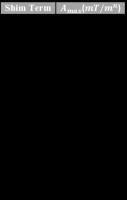 |
A Comparison of Optimization Algorithms for Localized in-vivo B0
Shimming 
Sahar Nassirpour1,2, Paul Chang1,2,
Ariane Fillmer3,4, and Anke Henning1,3
1Max Planck Institute For Biological Cybernetics,
Tübingen, Germany, 2IMPRS
for Cognitive and Systems Neuroscience, Eberhard Karls
University of Tübingen, Tübingen, Germany, 3Institute
for Biomedical Engineering, UZH and ETH Zürich, Zürich,
Switzerland, 4Physikalisch-Technische
Bundesanstalt, Berlin, Germany
This work presents a study on the performance of several
least-squares optimization algorithms used for localized
in-vivo B0 shimming.
Seven different algorithms were tested in 4 different shim
volumes in the brain: global shimming region, single slice,
and single voxels in two different positions with 3rd order
shimming at 7T. Each algorithm's robustness and convergence
were tested against noisy inputs and different starting
values. The results give an interesting overview of the
properties of each algorithm and their applicability. The
regularized iterative inversion algorithm proves to be the
best algorithmic approach suited to this problem.
|
| |
08:24
 |
1150.
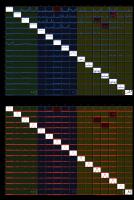 |
Full matrix pre-emphasis for higher-order dynamic shimming with
1 kHz bandwidth 
Laetitia Vionnet1, Yolanda Duerst1,
Signe Johanna Vannesjo1,2, Simon Gross1,
and Klaas Paul Pruessmann1
1Institute for Biomedical Engineering, University
and ETH Zurich, Zurich, Switzerland, 2FMRIB
centre, Nuffield Department of Clinical Neuroscience,
University of Oxford, Oxford, United Kingdom
Full matrix pre-emphasis was used for slice-wise dynamic
shimming.
|
| |
08:36
|
1151.
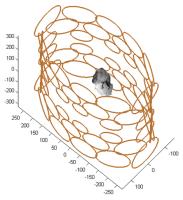 |
Multi-Coil B0 shimming of the Human Heart: A Theoretical
Assessment - Permission Withheld
Wolfram Mattar1, Christoph Juchem2,
Maxim Terekhov3, and Laura Schreiber3
1Department of Radiology, Section of Medical
Physics, Johannes Gutenberg University Medical Center,
Mainz, Germany, 2Departments
of Radiology and Imaging Sciences, and Neurology, Yale
University School of Medicine, New Haven, CT, United States, 3Department
of Cellular and Molecular Imaging, Comprehensive Heart
Failure Center, Wuerzburg, Germany
This study entails a comprehensive, theoretical analysis of
B0 shimming
capabilities in the human heart. Three-dimensional B0 distributions
over the in vivo human heart are addressed with various
spherical harmonic and multi-coil shimming (shimming with
individual placed magnetic coils to modify the B0 field)
approach in a static, dynamic and a hybrid fashion. The
results of the study show that, as expected, the global
standard static spherical harmonic shimming (clinical
standard) are generally inferior in comparison with the
results of specifically tailored and customized shimming
methods based on dynamic and multi-coil approaches.
|
| |
08:48
|
1152.
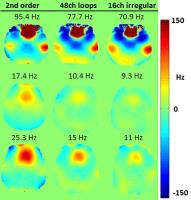 |
B0 shimming at 9.4T using a multicoil approach – coil design
with genetic algorithm 
Irena Zivkovic1, Christian Mirkes1,2,
and Klaus Scheffler1,2
1High Field MRI Department, Max Planck Institute
for Biological Cybernetics, Tuebingen, Germany, 2Dept.
for Biomedical Magnetic Resonance, University of Tuebingen,
Tuebingen, Germany
It is a big challenge to produce as homogeneous as possible
B0 static magnetic field. Susceptibility differences between
the tissue and air introduce inhomogeneities especially
pronounced at high fields. Recently proposed close fitting
array of circular loops provide improvement in B0 shimming.
Based on the same concept, we proposed coil elements with
irregular shape. The shape of the coils was designed by
using of genetic algorithm. Theoretical investigation showed
that performance of the 16 channel array of irregular
elements was comparable or better than 48 channel array
consisting loop elements.
|
| |
09:00
|
1153.
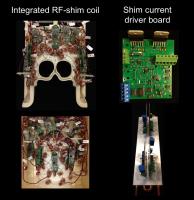 |
Improving the efficiency of integrated RF-shim arrays using
hybrid coil designs and channel placement and compression via a
genetic algorithm 
Jason P Stockmann1, Bastien Guerin1,2,
and Lawrence L Wald1,2
1A. A. Martinos Center for Biomedical Imaging,
Massachusetts General Hospital, Charlestown, MA, United
States, 2Harvard
Medical School, Boston, MA, United States
Integrated RF-shim coils combine RF receive arrays and
matrix shim arrays into a single set of close-fitting loops,
provide a promising alternative to spherical harmonic shim
coils for compensating dynamic high-order B0 offsets
in the brain. However, the potentially large design space
for optimizing these arrays remains little explored. In
this work, we investigate ways to improve the efficiency of
RF-shim coils by (a.) creating “hybrid” RF-shim arrays that
use additional shim-only loops over the face for targeted
shimming of the frontal lobes and (b.) using a genetic
algorithm to choose optimal subarrays of coils for shimming,
thus reducing hardware complexity.
|
| |
09:12
|
1154.
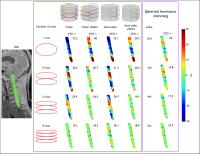 |
Optimization of geometry for combined RF/shim coil arrays for
the spinal cord 
Grégoire Germain1, Jason Stockmann2,
Ryan Topfer1, Lawrence L Wald2,3,
Nikola Stikov1,4, and Julien Cohen-Adad1,5
1Institute of Biomedical Engineering, École
Polytechnique de Montréal, Montréal, QC, Canada, 2Athinoula
A. Martinos Center for Biomedical Imaging, Department of
Radiology, Athinoula A. Martinos Center for Biomedical
Imaging, Charlestown, MA, United States, 3Harvard
Medical School, Boston, MA, United States, 4Montreal
Heart Institute, Université de Montréal, Montréal, QC,
Canada, 5Functional
Neuroimaging Unit, CRIUGM, Université de Montréal, Montréal,
QC, Canada
Spatial variations of B0 in the region of the
spinal cord are known to cause many artifacts. Local
combined RF/shim coil array could provide an alternative to
spherical harmonic shim coil. Here, we simulated several
realistic coil array geometries for spinal cord imaging and
demonstrated that arrays of 16 coils could outperform 3rd order
spherical harmonic shimming in the ROI. Simulations also
revealed that precise configurations for the coils can
improve shimming performance without SNR loss.
|
| |
09:24
|
1155.
 |
Generating unilateral field modulation for MRI using a
pyrolytic-graphite-based Halbach array 
Richard Bowtell1
1University of Nottingham, Nottingham, United
Kingdom
A flat Halbach array
consisting of an array of long, thin permanent magnets whose
magnetization orientation varies linearly with position, has
the interesting property of generating a unilateral field
perturbation. Such a pattern of field variation could be
usefully employed in MRI, for example for attenuating
signals from surface structures. Here we show that a Halbach
array can be formed by exposing appropriately oriented
strips of material with anisotropic magnetic susceptibility
to a strong static field, and also validate the predicted
behaviour in experiments carried at 3T using a 40-element
structure formed from pieces of pyrolytic graphite sheet.
|
| |
09:36
|
1156.
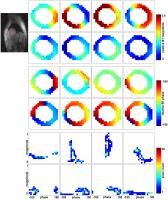 |
A two-stage RF shimming method for 7T human first-pass
myocardial perfusion 
Yuehui Tao1, Aaron T. Hess1, and
Matthew D. Robson1
1OCMR, Radcliffe Department of Medicine,
University of Oxford, Oxford, United Kingdom
RF shimming usually aims at uniform transmit field. For 7T
human first-pass myocardial perfusion, maximizing the lowest
transmit field strength is beneficial. The shimming
optimization cost function corresponding to the lowest
strength is not smooth, leading to impractically long
shimming calculation if all transmit magnitudes and phases
are optimized simultaneously. We evaluate several
optimization strategies for static RF shimming for
maximizing the lowest transmit field strength within a
practical duration, and propose a two-stage method to
accelerate in situ shimming calculation. In our experiments,
this proposed method consistently found near optimal
solutions in less than 10 seconds.
|
| |
09:48
 |
1157.
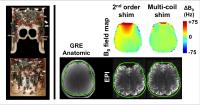 |
Open-source, low-cost, flexible, current feedback-controlled
driver circuit for local B0 shim coils and other applications 
Nick Arango1, Jason P Stockmann2,
Thomas Witzel2,3, Lawrence Wald2,3,
and Jacob White1
1Electrical Engineering and Computer Science,
Massachusetts Institute of Technology, Cambridge, MA, United
States, 2A.
A. Martinos Center for Biomedical Imaging, Massachusetts
General Hospital, Charlestown, MA, United States, 3Harvard
Medical School, Boston, MA, United States
We demonstrate a low-cost (<$75/channel), open source,
scalable, multi-channel current supply board that can
provide up to 8 amps per channel for driving inductive loads
such as local B0 shim
coils. The design shows excellent stability while retaining
sufficient gain in the audio frequency range to reject
disturbances (e.g. gradient switching) and maintain stable
output current.
|
|











